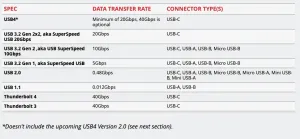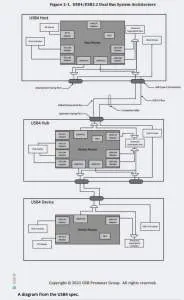(Ars Technica) USB has come a long way since the 12Mbps days of the ’90s. It has waved goodbye to USB-B and is inching away from USB-A in favor of the slim, reversible USB-C connector. Data transfer rates have increased so dramatically that we can run powerful setups with high-resolution monitors, speedy external storage, and numerous other devices from the USB Implementers Forum’s latest open standard, USB4.
USB4 unifies the USB and Intel Thunderbolt protocols for the first time, expanding USB’s capabilities while further dividing the technology into different performance classes. Adding features like dynamic bandwidth allocation ensures that USB4 is by far the most advanced USB generation. While there are PCs, docks, and cables supporting USB4, we’ve yet to see everything the protocol can do, like powering an eGPU without Intel branding.
With all that going on, we thought it would be a great time to put a spotlight on the latest and greatest generation of USB. We’ve whipped up a handy refresher for all things USB4, breaking down the various key aspects of the spec, from how it differs from other specs to protocol tunneling, Alt Mode, and power delivery.
Table of Contents
- USB4 vs. USB 3 vs. Thunderbolt at a glance
- USB4 Version 2.0
- USB4 vs. USB-C
- What is USB4?
- 40 gigabits per second
- Dynamic bandwidth allocation
- Protocol tunneling: USB 3.x, DisplayPort, and PCIe
- USB4 Alt Mode
- USB4 240W Power Delivery
- USB4 vs. Thunderbolt 4
- The future of USB
USB4 vs. USB 3 vs. Thunderbolt at a glance
We’ll be diving deeper into USB4 and related standards shortly. But if you want a quick overview of how currently available USB generations compare against each other and Intel’s more recent iterations of Thunderbolt, refer to the table below (note that speeds are max theoretical transfer rates):

USB4 Version 2.0
The table above doesn’t include the upcoming “USB4 Version 2.0,” since the specification isn’t released yet. Announced on September 1, it’s supposed to enable up to 80Gbps over USB-C through a new physical layer architecture that uses “newly defined,” as the USB Promoter Group put it, 80Gbps USB-C active cables and the 40Gbps USB-C passive cables that already exist today.
USB4 Version 2.0 will also boost protocol tunneling performance by leveraging the larger bandwidth, with expected improvements including USB 3.2 tunneling past 20Gbps.
The USB-IF expects to publish the spec, as well as relevant updates to the USB-Type-C and USB Power Delivery (USB PD) standards, by November 2022.
USB4 vs. USB-C
Now, some basics. How does USB4 differ from USB-C?
You can think of USB Type-C (or USB Type-A, etc.) as the physical shape of the port and plug, and USB4 (or USB 3.2, Thunderbolt 4, etc.) as the underlying technology. All USB4 products use the USB-C connector, but not all USB-C cables and ports use the USB4 protocol.
 Enlarge / Just because it’s USB-C doesn’t mean you know which USB standard it uses.
Enlarge / Just because it’s USB-C doesn’t mean you know which USB standard it uses.
USB4 is the latest generation of USB, which is maintained by the USB Implementers Forum (USB-IF). The USB4 architecture and prior generations of USB, like USB 3.2 and 2.0, refer to the cable bus supporting data exchange between a host computer or device and peripherals, as the USB-IF puts it in the USB4 specification.
A USB-C cable or port could use USB4 technologies or older generations of the USB architecture, like USB 3.2.
The USB-IF has a detailed specification for USB4 and another for USB-C cables and connectors.
What is USB4?
The USB-IF released the USB4 spec in 2019, building on USB 2.0 and 3.2, as well as the Thunderbolt 3 spec that Intel made royalty-free.
USB4 is compatible with USB 2.0 and 3.2 and can support Thunderbolt 3 and 4. Remember that you’ll get the lowest data transfer rate available. For example, if you plug a USB4 40Gbps cable into a USB 3.2 Gen 1 port on your laptop, expect the cable to work at 5Gbps.
USB4 differs from USB 3.2 in that it can operate at 40Gbps; however, that max theoretical transfer rate is optional. At a minimum, USB4 requires 20Gbps, just like USB 3.2 Gen 2×2.
USB4 also introduces the ability to use multiple data and display protocols simultaneously and allocate total available bandwidth based on current needs.
40 gigabits per second
USB4 must operate at 20Gbps, but it can also support 40Gbps speeds using a pair of bidirectional cable lanes.

Jeff Ravencraft, president and COO of USB-IF, told Ars that USB4’s multi-monitor support depends on the computer “and is a question of how many streams a host can support, but “from a bandwidth perspective, the maximum is four 1K monitors at [a refresh rate of] 120 Hz, two 4K monitors at 120 Hz, and one 8K monitor at 30 Hz.”
But if USB4 can be 20Gbps or 40Gbps, how do you know what you’re getting?
Your best bet is to carefully examine spec sheets. But to simplify things, in 2021, the USB-IF introduced a logo program that included USB4 transfer rates. The badges look like this:

Speed is also limited by distance. Ravencraft said that max passive cable length is 3.3 feet (1 meter), while active copper cables can reach 13.1 feet (4 meters) and operate at 40Gbps, and “active optical cables can be much longer.”
The USB-IF is moving away from USB sub-generation names like USB 3.2, with USB4 Version 2.0” being the next big update. Meanwhile, USB-IF is pushing branding like “USB 40Gbps,” “USB 20Gbps,” and “SuperSpeed USB 20Gbps,” aka USB 3.2 Gen 2×2. However, the accompanying logos are optional and require USB-IF certification. You’ll still see plenty of products simply labeled as USB4, which doesn’t tell you the data transfer rate.
Dynamic bandwidth allocation
USB4’s other headline feature is its protocol tunneling, including USB 3.x, DisplayPort, and, optionally, PCIe. Briefly, this feature allows USB4 to allocate bandwidth based on current needs. As an example, imagine using a USB4 dock to connect your PC, monitor, and external SSD. USB4 will allocate the necessary bandwidth to the monitor—say 10Gbps—and give the remaining 30Gbps to the external drive.






